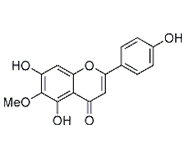Home
Products
Hispidulin



| Product Name | Hispidulin |
| Price: | $116 / 10mg |
| Catalog No.: | CN05530 |
| CAS No.: | 1447-88-7 |
| Molecular Formula: | C16H12O6 |
| Molecular Weight: | 300.3 g/mol |
| Purity: | >=98% |
| Type of Compound: | Flavonoids |
| Physical Desc.: | Yellow powder |
| Source: | The herbs of Ambrosia artemisiifolia Linn. |
| Solvent: | Chloroform, Dichloromethane, Ethyl Acetate, DMSO, Acetone, etc. |
| SMILES: | COc1c(O)cc2c(c1O)c(=O)cc(o2)c1ccc(cc1)O |
| Contact us | |
|---|---|
| First Name: | |
| Last Name: | |
| E-mail: | |
| Question: | |
| Description | Hispidulin is a natural flavone with a broad spectrum of biological activities. Hispidulin is a Pim-1 inhibitor with an IC50 of 2.71 μM. |
| Target | IC50: 2.71 μM (Pim-1)[1] |
| In Vitro | Hispidulin induces cell death in a dose- and time-dependent manner in HepG2 cells. Hispidulin induces apoptosis through mitochondrial dysfunction, which is characterized by decreased Bcl-2/Bax ratio, disrupted mitochondrial membrane potential and increased release of cytochrome C and activated capase-3[2]. |
| In Vivo | Hispidulin shows significant inhibitory effect on mice tumor size[2]. Hispidulin treatment effectively prevents ovariectomy-induced body weight loss and attenuates ovariectomy-induced bone loss. Hispidulin treatment also decreases trabecular spacing in ovariectomy mice[3]. Intraperitoneally administering hispidulin(10 or 50mg/ kg) to rats 30 min before intraperitoneally injecting kainic acid (15mg/kg) increases seizure latency and decreases seizure score. In addition, hispidulin substantially attenuates kainic acid-induced hippocampal neuronal cell death, and this protective effect is accompanied by the suppression of microglial activation and the production of proinflammatory cytokines such as interleukin-1β, interleukin-6, and tumor necrosis factor-α in the hippocampus[4]. |
| Cell Assay | HepG2 cells are treated with different concentrations of hispidulin (50, 100, 200 μM) for 24, 48 and 72 h. Following treatment, cells are further incubated with MTT reagents at 37°C for 4 h before DMSO is added, to dissolve farmazan crystals, and absorbance is measured at 570 nm in a microplate reader[2]. |
| Animal Admin | Mice: Tumor are established in mice. Mice are treated with DMSO or Hispidulin at a dosage of 10, 20 or 40 mg/kg/day for 35 days. The body weight of tumour-bearing mice is recorded every week and tumour volume is calculated [2]. |
| Density | 1.5±0.1 g/cm3 |
| Boiling Point | 601.5±55.0 °C at 760 mmHg |
| Flash Point | 230.1±25.0 °C |
| Exact Mass | 300.063385 |
| PSA | 100.13000 |
| LogP | 1.60 |
| Vapour Pressure | 0.0±1.8 mmHg at 25°C |
| Storage condition | Desiccate at -20°C |